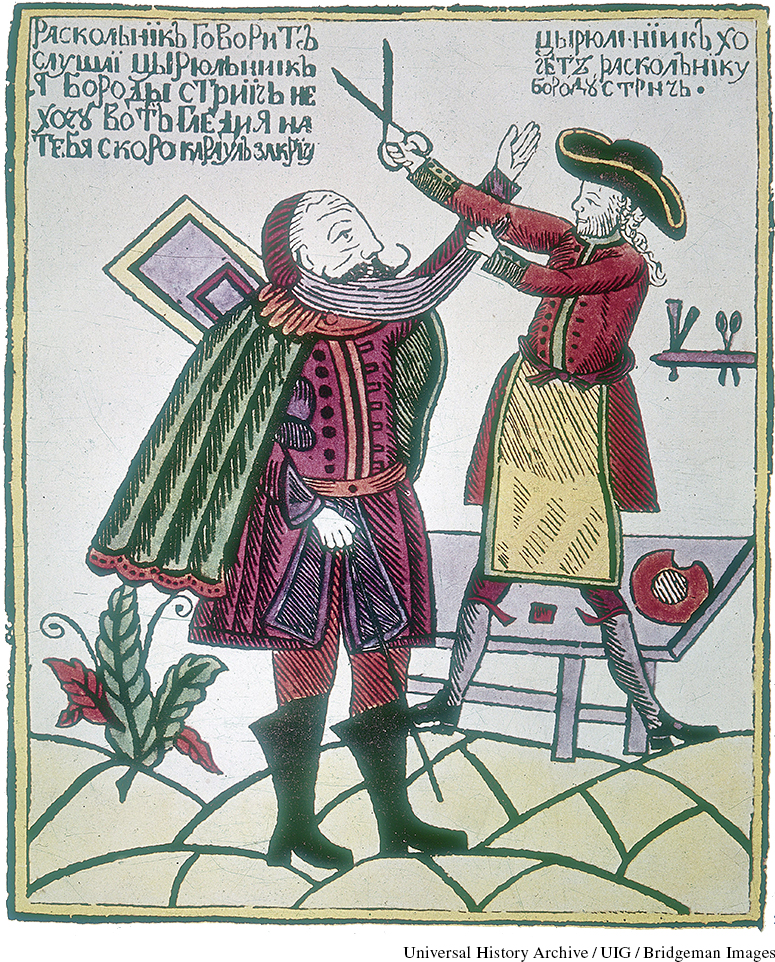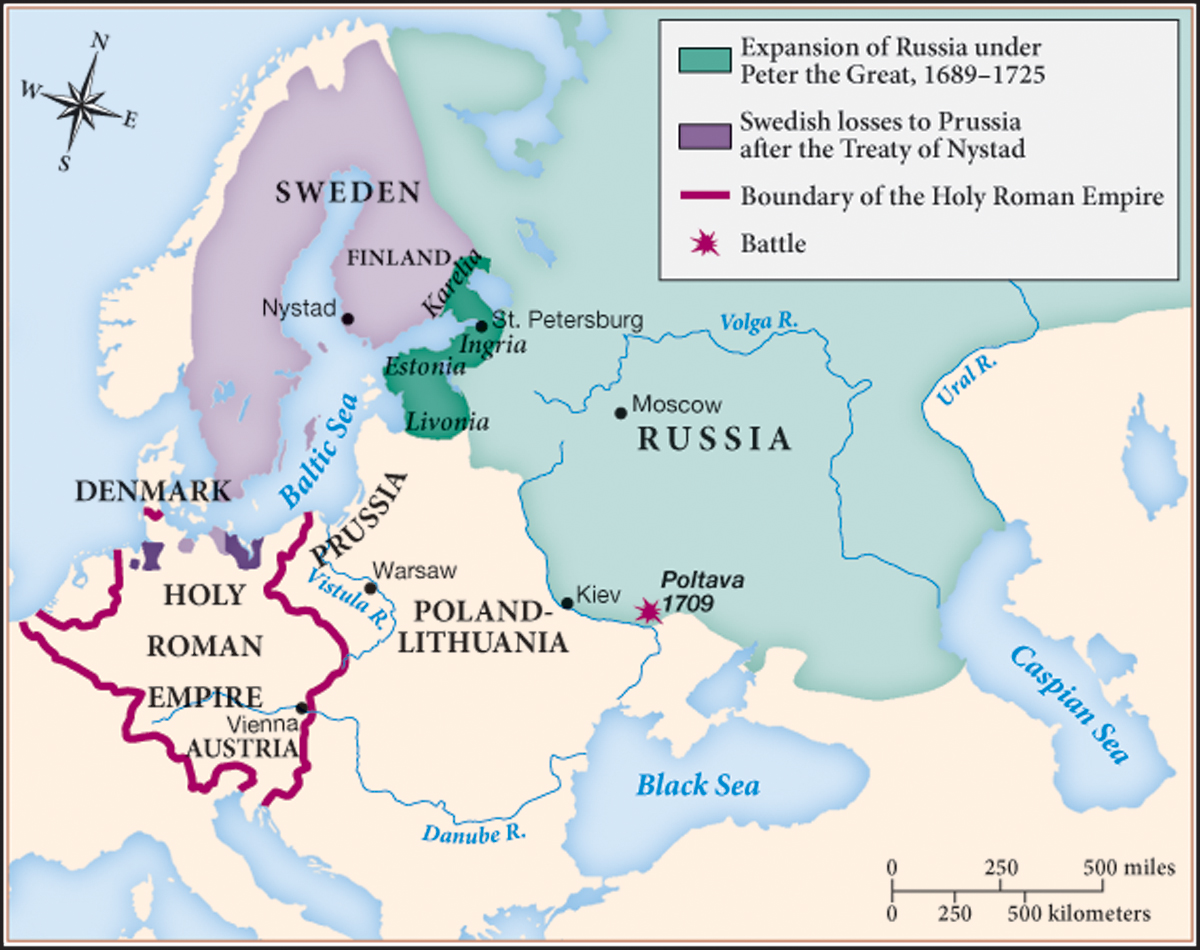Russia’s Emergence as a European Power
Russia’s Emergence as a European Power
The commerce and shipbuilding of the Dutch and British so impressed Russian tsar Peter I (r. 1689–1725) that he traveled incognito to their shipyards in 1697 to learn their methods firsthand. Known to history as Peter the Great, he dragged Russia kicking and screaming all the way to great-power status. Although he came to the throne while still a minor (on the eve of his tenth birthday), grew up under the threat of a palace coup, and enjoyed little formal education, his accomplishments soon matched his seven-foot-tall stature. Peter transformed public life in Russia and established an absolutist state based on the Western model. His attempts to create a society patterned after western Europe, known as Westernization, ignited an enduring controversy: Did Peter set Russia on a course of inevitable Westernization required to compete with the West? Or did he forever and fatally disrupt Russia’s natural evolution into a distinctive Slavic society?
To pursue his goal of Westernizing Russian culture, Peter set up the first laboratories and technical schools and founded the Russian Academy of Sciences. He ordered translations of Western classics and hired a German theater company to perform the French plays of Molière. He replaced the traditional Russian calendar with the Western one,* introduced Arabic numerals, and brought out the first public newspaper. He ordered his officials and the nobles to shave their beards and dress in Western fashion.

Peter encouraged foreigners to move to Russia to offer their advice and skills, especially for building the capital city. Named St. Petersburg after the tsar, the new capital symbolized Russia’s opening to the West. Construction began in 1703 in a Baltic province that had been recently conquered from Sweden. By the end of 1709, thirty thousand laborers had been enlisted in the construction. Peter ordered skilled workers to move to the new city and commanded all landowners possessing more than forty serf households to build houses there. In the 1720s, a German minister described St. Petersburg “as a wonder of the world, considering its magnificent palaces, . . . and the short time that was employed in the building of it.” At Peter’s death in 1725, the new city had forty thousand residents.
Peter aimed to set Russia on a new course. At his new capital he tried to improve the traditionally denigrated, secluded status of women by ordering them to dress in European styles and appear publicly at his dinners for diplomatic representatives. A foreigner headed every one of Peter’s new technical and vocational schools, and for its first eight years the new Academy of Sciences included no Russians. Every ministry was assigned a foreign adviser. Upper-class Russians learned French or German, which they spoke even at home. Such changes affected only the very top of Russian society, however; the mass of the population had no contact with the new ideas and ended up paying for the innovations either in ruinous new taxation or by building St. Petersburg, a project that cost the lives of thousands of workers. Serfs remained tied to the land, completely dominated by their noble lords.
Peter also reorganized government and finance on Western models and, like other absolute rulers, strengthened his army. With ruthless recruiting methods, which included branding a cross on every recruit’s left hand to prevent desertion, he forged an army of 200,000 men and equipped it with modern weapons. He not only built the first navy in Russian history but also created schools for artillery, engineering, and military medicine. Not surprisingly, taxes tripled.
The tsar allowed nothing to stand in his way. He did not hesitate to use torture, and he executed thousands. He gave a special guard regiment unprecedented power to expedite cases against those suspected of rebellion, espionage, pretensions to the throne, or just “unseemly utterances” against him. Because his only son, Alexei, had allied himself with Peter’s critics, the tsar threw him into prison, where the young man mysteriously died.
To control the often restive nobility, Peter insisted that all noblemen engage in state service. The Table of Ranks (1722) classified them into military, administrative, and court categories, a codification of social and legal relationships in Russia that would last for nearly two centuries. Because the nobles lacked a secure independent status, Peter could command them to a degree that was unimaginable in western Europe. State service was not only compulsory but also permanent. Moreover, the male children of those in service had to be registered by the age of ten and begin serving at fifteen. To increase his authority over the Russian Orthodox church, Peter allowed the office of patriarch (supreme head) to remain vacant, and in 1721 he replaced it with the Holy Synod, a bureaucracy of laymen under his supervision.
Peter the Great’s success in building up state authority changed the balance of power in eastern Europe. First he took on Sweden, which had dominated the Baltic region since the Thirty Years’ War (1618–1648). Peter joined an anti-Swedish coalition in 1700 with Denmark, Saxony, and Poland, but the ensuing Great Northern War (1700–1721) went badly for the allies at first. The Swedes defeated Denmark, quickly marched into Poland and Saxony, and then invaded Russia. Peter’s rebuilt army finally defeated the Swedes at the battle of Poltava (1709), taking twenty-three thousand Swedish soldiers prisoner and marking the end of Swedish imperial ambitions in the Baltic (Map 17.3). Russia could then begin to compete with the great powers Prussia, Austria, and France.

When the tide turned in the Great Northern War, King Frederick William I of Prussia (r. 1713–1740) joined the Russian side and gained new territories. Prussia had to make the most of every military opportunity because it was much smaller in size and population than the other powers. Frederick William doubled the size of the Prussian army; though still smaller than those of his rivals, it was the best-trained and most up-to-date force in Europe. The army so dominated life in Prussia that the country earned the label “a large army with a small state attached.” One of the first rulers to wear a military uniform as his everyday dress, Frederick William subordinated the entire domestic administration to the army’s needs. He financed the army’s growth by subjecting all the provinces to an excise tax on food, drink, and manufactured goods and by increasing rents on crown lands.